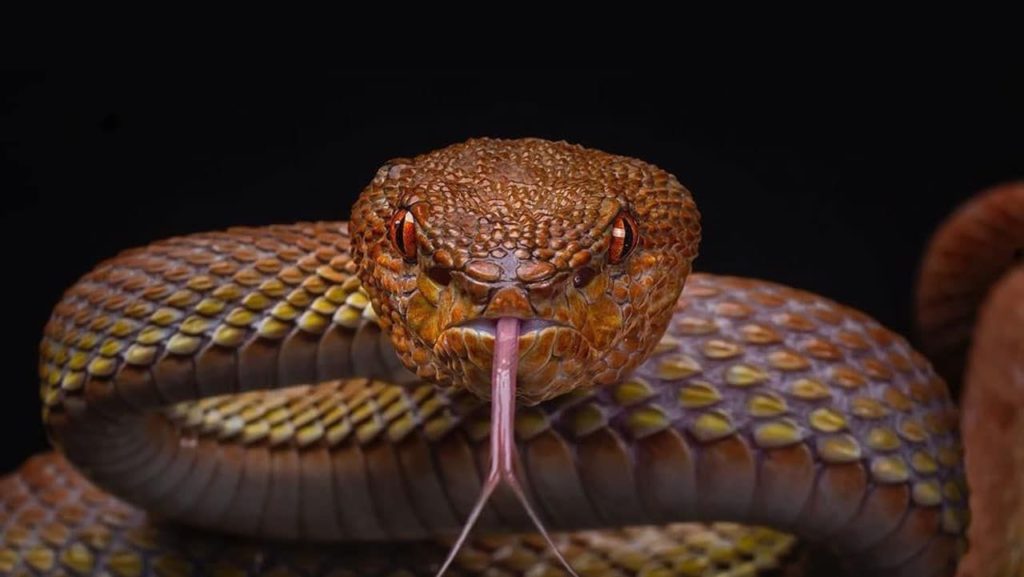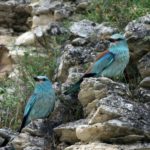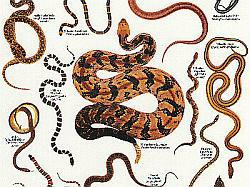 As the month of May is usually the time of year such things to come out of their hibernation slumber, we thought we would give you a run down of the various species of snake that you may come across in North Cyprus! Those of us who live here are fairly familiar with the varieties that we may all come across and, as most of them are pretty harmless, we would advise you not to panic should you come across one! Most of us treat snakes with a kind of scared disgust, imagining them to be slippery reptiles that will leap out of bushes and bite us, when in all honesty all they want is to be left alone to live quiet lives!
As the month of May is usually the time of year such things to come out of their hibernation slumber, we thought we would give you a run down of the various species of snake that you may come across in North Cyprus! Those of us who live here are fairly familiar with the varieties that we may all come across and, as most of them are pretty harmless, we would advise you not to panic should you come across one! Most of us treat snakes with a kind of scared disgust, imagining them to be slippery reptiles that will leap out of bushes and bite us, when in all honesty all they want is to be left alone to live quiet lives!
It is worth noting at the beginning of this article that if you are ever unfortunate enough to be bitten by a venomous snake, then keeping calm is essential to slow the poison from circulating in the bloodstream. Seek medical help (call the North Cyprus ambulance service on 112 if you are unsure of the nearest hospital) and where possible, determine the pattern and colour of the snake which will help medical staff to administer the correct antidote required to counteract the poison.
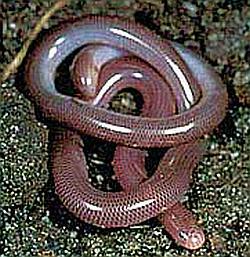
Additionally, if you happen across a snake then leave it alone! Even non-poisonous varieties may still bite or even whip their tails to defend themselves so turn around and walk the other way. If undisturbed then most will either slide away or will not react to your presence at all.
So, our rundown of the various snakes you may see in North Cyprus (starting with the least scary!):
Worm Snake
A very strange looking thing which doesn’t really have a defined head! This species only grows to around 30cm in length, is a shiny pink brown colour and has tiny dark spots for eyes. You are more likely to find these little fellas hiding under stones during the day as they don’t like the sun.
The Large Whip Snake or Black Snake
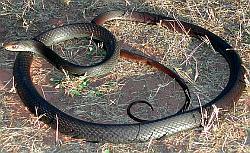
This snake is common in North Cyprus, but luckily is non-venomous.However, it kills its prey by constriction. It can grow to around 2.5m in length, is usually reddish brown and olive in colour when young, turning a blue-black colour on maturing. Their habitat is varied so you may see them in fields, forests, mountain areas and sometimes up a tree raiding a bird’s nest. The interesting thing about this snake is that it kills and eats other snakes and has been imported to the island to keep the poisonous varieties at bay!
The Cyprus Whip Snake
Another non-venomous species this snake only exists in Cyprus. Again, it changes colour from an olive-brown to a dark brown-black on maturing. It can grow to around 1.5m and you may see it in rocky but well vegetated areas near to streams. It feeds on a diet mainly consisting of lizards and may bite if threatened.
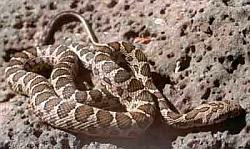
The Coin Snake
This particular snake although non-venomous is often mistaken for the Blunt Nosed Viper which is very dangerous. It will hiss loudly to let you know of its presence if it feels threatened and can give a very painful bite. Growing to around 1.4m it has a large head and is of a yellow or gray brown colour and has distinctive markings on the top and side of its head with a roundish pattern along its length. It feeds on a diet consisting of lizards, mice, small birds and geckos. You may come across this snake around the coastlines and mountain areas of North Cyprus.
The Cat Snake
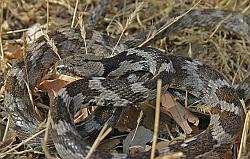
Possibly one snake that you may not see too often as it’s a nocturnal hunter and is pretty slow moving; but it is venomous (worth noting here that there have been no reports of it having bitten a human before!). If threatened it will coil up into a ring like shape, raise itself and hiss at you. It can grow to around 1m in length, has a yellow-brown body colour covered with black spots and lives mainly on a diet of lizards. It’s not a particularly common species but you may happen across them in some coastal areas as well as the Troodos mountain area in the south.
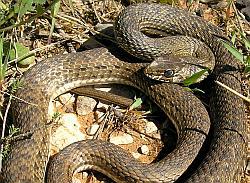
The Montpellier Snake
This one is venomous but it’s very rare that it will bite a human and the poison is not life threatening. A bite however can cause painful swelling and headaches so medical advice should be sought if you are bitten. Adults are usually of a grey-brown colour and can grow to 2m in length. It has very coarse scales which sound like grinding when slithering and has ridged eyebrows that make it look quite menacing. You will see this variety of snake in many places such as forests, open fields both in coastal and mountain areas. It feeds mainly on a diet of lizards, other small mammals and insects.
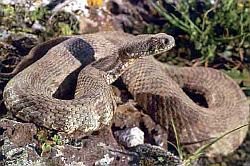
The Blunt Nosed Viper
This is the most dangerous snake in North Cyprus and you must be very careful should you come across one as its bite can be deadly. It is also a protected species and it is illegal to kill them (not that you should consider killing any snake of course!). It is extremely well camouflaged being a grey-brown colour which blends in with the rocky terrain that it favours, so keep alert whilst out walking in mountain areas. However, they are known to like areas around swimming pools during the hotter summer months (perhaps because of the wildlife that will come to drink at pool-sides). In shape it can be quite fat in appearance and growing to around 1.5m and is determined by its diamond patterned back. It will warn you of its presence with hissing, but will attack quickly if threatened. Its bite is made more dangerous by the fact that it imbeds its fangs into tissue and pumps large amounts of poison into the wound. We have come across these snakes frequently whilst out walking in the mountains, and more often than not they will slither away faster than you could run away!
We hope that this has not discouraged you from holidaying in North Cyprus, but as you will agree it is worth knowing about! Just have your wits about you whilst out walking, carry a mobile phone where possible and don’t poke at or wind up a snake for a laugh! CAUTION IS THE WORD.
If you would like more information on the various fauna in North Cyprus then you can read about those and more within our North Cyprus Nature section.

